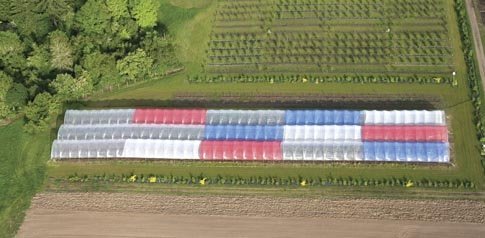
Tunnels may have a place in cherry orchards in the Pacific Northwest, protecting trees from disease and weather while increasing packouts from improved fruit quality. Oregon State University researchers are evaluating cherry production under tunnels as part of a project studying horticultural management systems for high-value fresh and brined cherries.
While cherry cracking from rain is common in Oregon’s cherry-growing regions, Dr. Anita Azarenko said that bacterial canker (Pseudomonas syringae) is also a major concern and one of the driving factors behind the tunnel project. Azarenko, an OSU horticulturist, is leading a comprehensive research project to identify cultivars, rootstocks, and training systems suitable for fresh-market cherries grown in Oregon’s Willamette Valley and to evaluate alternative cherry cropping systems, such as tunnels and alternative orchard floor management. Brining cherries have traditionally been grown in the Willamette Valley, but orchardists there are interested in switching to higher value fresh-market cherries.
“We want to learn if tunnels can help us keep trees protected from bacterial canker as well as reduce rain cracking and improve packouts from less wind damage,” she said. Bacterial canker, on average, infects about 20 percent of the cherry trees in the Willamette Valley, killing trees and reducing yields from damaged fruiting wood and buds, she explained.
Intensive
About an acre of third-leaf, organic cherry trees are being grown under tunnels under drip irrigation at OSU’s Lewis Brown Horticulture Research Farm in Corvallis. The tunnels have covered the blush variety cherry trees since planting in the field. Trees are covered from mid-February to November, with the tunnels removed during winter to protect them from damage by winter storms. (Tunnels had to be rebuilt after their destruction by a windstorm in November 2006.)
Azarenko said the tunnel project is very intensive—almost 600 trees are planted per acre with 7 feet between trees and 8 feet between rows. “With such a high-density planting, part of the challenge will be keeping the trees within bounds of the tunnels,” she said. They are trying different pruning techniques to maintain tree height and keep trees open for light interception.
A different twist to the OSU research from other tunnel studies is the use of different-colored shade cloth used in conjunction with the plastic sheeting of the tunnels. The OSU researchers are studying red, pearl, and blue shade cloths, installed last year, to learn if different-colored material affects tree growth. The material is similar to hail cloth used by growers to protect fruit from hail damage.
“The idea is to see if we can manipulate growth with the different-colored nets,” Azarenko said. “And will the different colors impact fruit set and quality?”
Data collected last year during the second leaf found no significant difference in trunk cross-sectional area for any cultivar under any color netting, although Rainier was slightly more vigorous without colored netting, she reported. Leaf area and greenness were highest under the blue shade cloth, but there were no differences in the number of leaves, internode length, or shoot length.
Temperature data showed that the pearl cloth and control treatment (just tunnel sheeting without shade cloth) were the hottest treatments of all during the day, from 7 a.m. to 6 p.m., while red was the coolest during daytime hours. Blue was coolest during the night, from 8 p.m. to 6 a.m.
Challenges
Thus far, the trees under tunnels have bloomed about five days ahead of like varieties grown without tunnels, Azarenko said. They haven’t had any tree losses due to bacterial canker inside the tunnels, although they did have to spray sulfur at the end of last September for powdery mildew.
She worries that powdery mildew could be a drawback to the tunnels as the humidity inside may be conducive to mildew infection.
Pollination will also be a big challenge. Bumblebees have proved to be effective pollinators in Michigan State University tunnel studies, but bumblebees can’t be imported into Oregon because of quarantine regulations, Azarenko explained. She is working with an OSU apiarist to learn how to keep honeybees inside the tunnel as well as identify techniques to attract a native bumblebee species to the tunnels.
Pest control
The organic status of the trial will limit the options for pest control, including black cherry aphid. “Black cherry aphid has been a real problem for organic cherry growers because we don’t know what the natural predators are for the pest,” she said, adding that OSU entomologist Dr. Sujaya Rao is collaborating on the project. For cherry fruit fly, she plans to use GF-120, an organically approved bait that combines the biopesticide spinosad with a sugary attractant.
Ultimately, Azarenko wants to learn if the tunnels can improve fruit quality in a cost-effective manner and if trees will remain productive under the tunnels. She stressed that she is cooperating with other researchers to avoid duplicating research being done in other regions. Dr. Clark Seavert, OSU agricultural economist, is also a project collaborator, providing economic analysis.
The project is supported by the International Fruit Tree Association, Oregon Agricultural Experiment Station, Oregon Tilth, and PolySack, Inc. Those interested in supporting the research can contact Azarenko at anita.azarenko@oregonstate.edu.

Leave A Comment